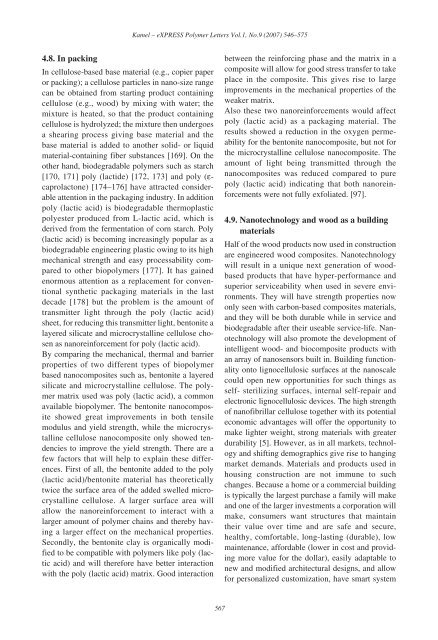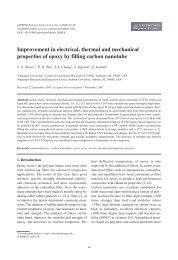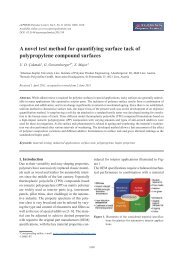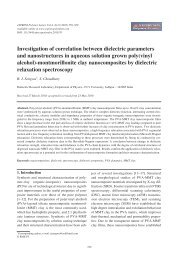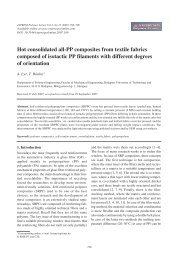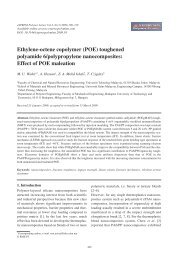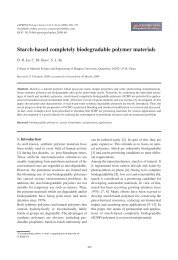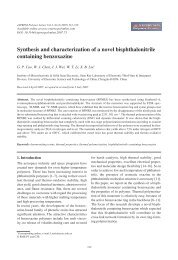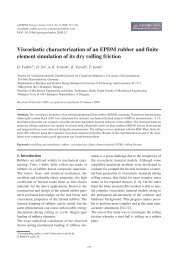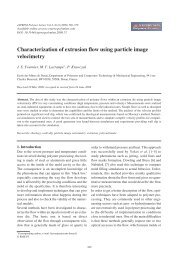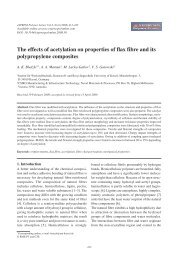Nanotechnology and its applications in lignocellulosic composites, a ...
Nanotechnology and its applications in lignocellulosic composites, a ...
Nanotechnology and its applications in lignocellulosic composites, a ...
Create successful ePaper yourself
Turn your PDF publications into a flip-book with our unique Google optimized e-Paper software.
Kamel – eXPRESS Polymer Letters Vol.1, No.9 (2007) 546–575<br />
4.8. In pack<strong>in</strong>g<br />
In cellulose-based base material (e.g., copier paper<br />
or pack<strong>in</strong>g); a cellulose particles <strong>in</strong> nano-size range<br />
can be obta<strong>in</strong>ed from start<strong>in</strong>g product conta<strong>in</strong><strong>in</strong>g<br />
cellulose (e.g., wood) by mix<strong>in</strong>g with water; the<br />
mixture is heated, so that the product conta<strong>in</strong><strong>in</strong>g<br />
cellulose is hydrolyzed; the mixture then undergoes<br />
a shear<strong>in</strong>g process giv<strong>in</strong>g base material <strong>and</strong> the<br />
base material is added to another solid- or liquid<br />
material-conta<strong>in</strong><strong>in</strong>g fiber substances [169]. On the<br />
other h<strong>and</strong>, biodegradable polymers such as starch<br />
[170, 171] poly (lactide) [172, 173] <strong>and</strong> poly (εcaprolactone)<br />
[174–176] have attracted considerable<br />
attention <strong>in</strong> the packag<strong>in</strong>g <strong>in</strong>dustry. In addition<br />
poly (lactic acid) is biodegradable thermoplastic<br />
polyester produced from L-lactic acid, which is<br />
derived from the fermentation of corn starch. Poly<br />
(lactic acid) is becom<strong>in</strong>g <strong>in</strong>creas<strong>in</strong>gly popular as a<br />
biodegradable eng<strong>in</strong>eer<strong>in</strong>g plastic ow<strong>in</strong>g to <strong>its</strong> high<br />
mechanical strength <strong>and</strong> easy processability compared<br />
to other biopolymers [177]. It has ga<strong>in</strong>ed<br />
enormous attention as a replacement for conventional<br />
synthetic packag<strong>in</strong>g materials <strong>in</strong> the last<br />
decade [178] but the problem is the amount of<br />
transmitter light through the poly (lactic acid)<br />
sheet, for reduc<strong>in</strong>g this transmitter light, bentonite a<br />
layered silicate <strong>and</strong> microcrystall<strong>in</strong>e cellulose chosen<br />
as nanore<strong>in</strong>forcement for poly (lactic acid).<br />
By compar<strong>in</strong>g the mechanical, thermal <strong>and</strong> barrier<br />
properties of two different types of biopolymer<br />
based nano<strong>composites</strong> such as, bentonite a layered<br />
silicate <strong>and</strong> microcrystall<strong>in</strong>e cellulose. The polymer<br />
matrix used was poly (lactic acid), a common<br />
available biopolymer. The bentonite nanocomposite<br />
showed great improvements <strong>in</strong> both tensile<br />
modulus <strong>and</strong> yield strength, while the microcrystall<strong>in</strong>e<br />
cellulose nanocomposite only showed tendencies<br />
to improve the yield strength. There are a<br />
few factors that will help to expla<strong>in</strong> these differences.<br />
First of all, the bentonite added to the poly<br />
(lactic acid)/bentonite material has theoretically<br />
twice the surface area of the added swelled microcrystall<strong>in</strong>e<br />
cellulose. A larger surface area will<br />
allow the nanore<strong>in</strong>forcement to <strong>in</strong>teract with a<br />
larger amount of polymer cha<strong>in</strong>s <strong>and</strong> thereby hav<strong>in</strong>g<br />
a larger effect on the mechanical properties.<br />
Secondly, the bentonite clay is organically modified<br />
to be compatible with polymers like poly (lactic<br />
acid) <strong>and</strong> will therefore have better <strong>in</strong>teraction<br />
with the poly (lactic acid) matrix. Good <strong>in</strong>teraction<br />
between the re<strong>in</strong>forc<strong>in</strong>g phase <strong>and</strong> the matrix <strong>in</strong> a<br />
composite will allow for good stress transfer to take<br />
place <strong>in</strong> the composite. This gives rise to large<br />
improvements <strong>in</strong> the mechanical properties of the<br />
weaker matrix.<br />
Also these two nanore<strong>in</strong>forcements would affect<br />
poly (lactic acid) as a packag<strong>in</strong>g material. The<br />
results showed a reduction <strong>in</strong> the oxygen permeability<br />
for the bentonite nanocomposite, but not for<br />
the microcrystall<strong>in</strong>e cellulose nanocomposite. The<br />
amount of light be<strong>in</strong>g transmitted through the<br />
nano<strong>composites</strong> was reduced compared to pure<br />
poly (lactic acid) <strong>in</strong>dicat<strong>in</strong>g that both nanore<strong>in</strong>forcements<br />
were not fully exfoliated. [97].<br />
4.9. <strong>Nanotechnology</strong> <strong>and</strong> wood as a build<strong>in</strong>g<br />
materials<br />
Half of the wood products now used <strong>in</strong> construction<br />
are eng<strong>in</strong>eered wood <strong>composites</strong>. <strong>Nanotechnology</strong><br />
will result <strong>in</strong> a unique next generation of woodbased<br />
products that have hyper-performance <strong>and</strong><br />
superior serviceability when used <strong>in</strong> severe environments.<br />
They will have strength properties now<br />
only seen with carbon-based <strong>composites</strong> materials,<br />
<strong>and</strong> they will be both durable while <strong>in</strong> service <strong>and</strong><br />
biodegradable after their useable service-life. <strong>Nanotechnology</strong><br />
will also promote the development of<br />
<strong>in</strong>telligent wood- <strong>and</strong> biocomposite products with<br />
an array of nanosensors built <strong>in</strong>. Build<strong>in</strong>g functionality<br />
onto <strong>lignocellulosic</strong> surfaces at the nanoscale<br />
could open new opportunities for such th<strong>in</strong>gs as<br />
self- steriliz<strong>in</strong>g surfaces, <strong>in</strong>ternal self-repair <strong>and</strong><br />
electronic <strong>lignocellulosic</strong> devices. The high strength<br />
of nanofibrillar cellulose together with <strong>its</strong> potential<br />
economic advantages will offer the opportunity to<br />
make lighter weight, strong materials with greater<br />
durability [5]. However, as <strong>in</strong> all markets, technology<br />
<strong>and</strong> shift<strong>in</strong>g demographics give rise to hang<strong>in</strong>g<br />
market dem<strong>and</strong>s. Materials <strong>and</strong> products used <strong>in</strong><br />
hous<strong>in</strong>g construction are not immune to such<br />
changes. Because a home or a commercial build<strong>in</strong>g<br />
is typically the largest purchase a family will make<br />
<strong>and</strong> one of the larger <strong>in</strong>vestments a corporation will<br />
make, consumers want structures that ma<strong>in</strong>ta<strong>in</strong><br />
their value over time <strong>and</strong> are safe <strong>and</strong> secure,<br />
healthy, comfortable, long-last<strong>in</strong>g (durable), low<br />
ma<strong>in</strong>tenance, affordable (lower <strong>in</strong> cost <strong>and</strong> provid<strong>in</strong>g<br />
more value for the dollar), easily adaptable to<br />
new <strong>and</strong> modified architectural designs, <strong>and</strong> allow<br />
for personalized customization, have smart system<br />
567


